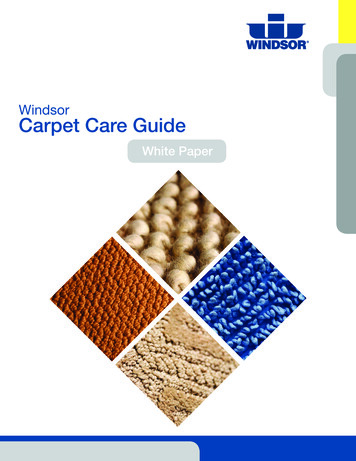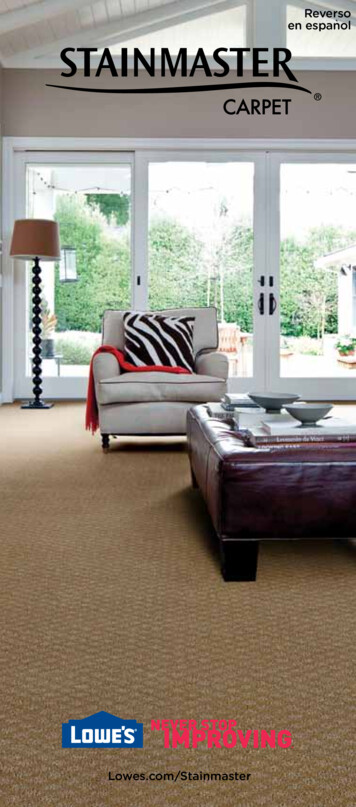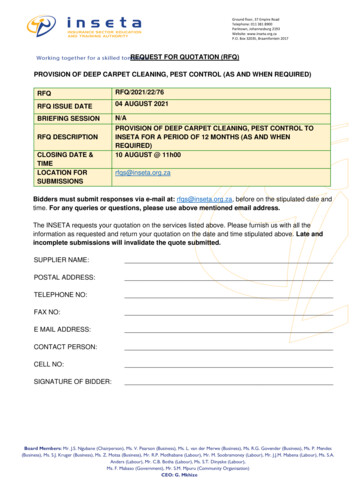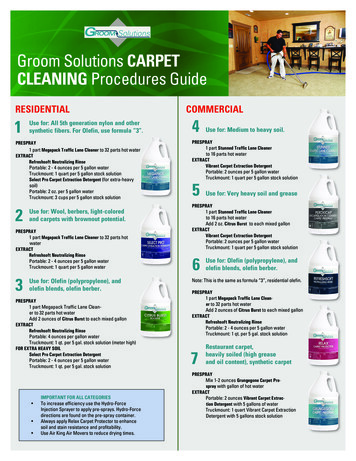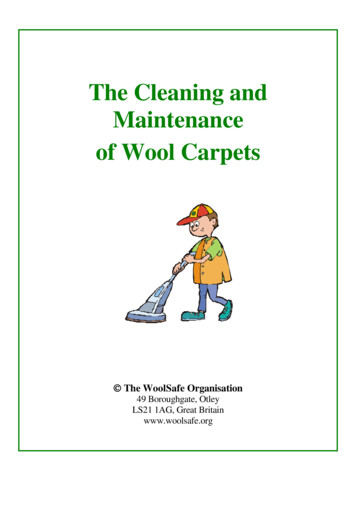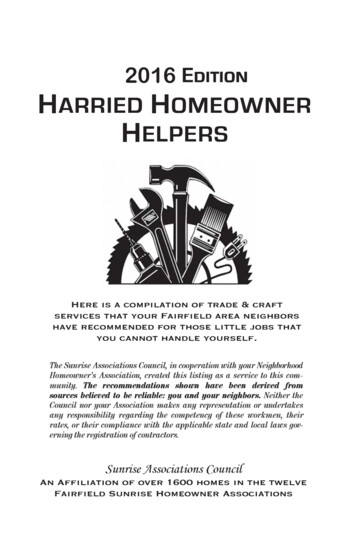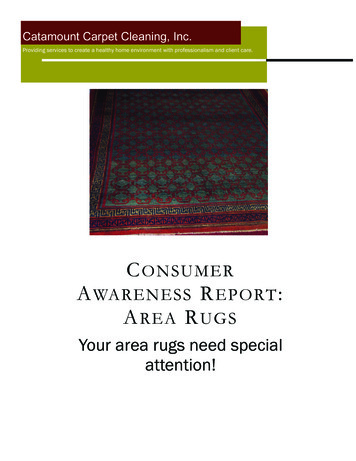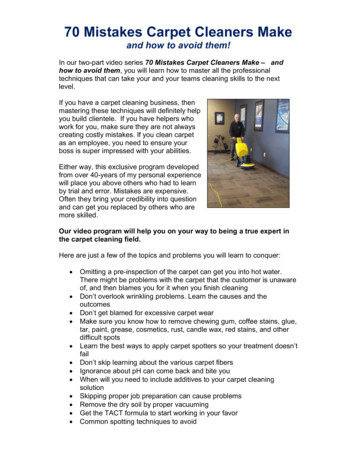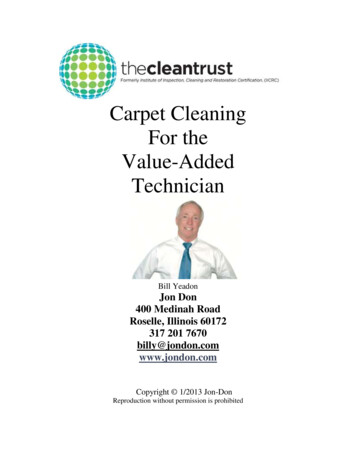
Transcription
Carpet CleaningFor theValue-AddedTechnicianBill YeadonJon Don400 Medinah RoadRoselle, Illinois 60172317 201 7670billy@jondon.comwww.jondon.comCopyright 1/2013 Jon-DonReproduction without permission is prohibited
A message from your instructorWhen I started in the cleaning industry in 1975 things were a bit differentthan today. The IICRC (then IICUC) had just begun and probably had fewerthan 100 registrants. Training was very hard to find.Carpet fibers were nylon, polyester and acrylic. Backings were made of juteand the hot colors were avocado, burnt orange, harvest gold, brown andblue. Most popular style was shag. Oh yes disco was king.The field of cleaning chemistry was in its early stages. In other words pHwas king and browning due to those jute backings was an everydayoccurrence. The solvents would dissolve most anything oily and rustremovers could eat the bone marrow in your fingers as well as cloud glass.Wands easily weighed 20 pounds and guide handles had not been added yetwhich left technicians fatigued by lunchtime. Upholstery tools were the sizeof today’s stair tools and if it wasn’t a Herculon sofa you could guaranteebrowning and some shrinkage. If there was a mistake to be made I made it.Of course everything wasn’t bad; my 1975 Chevy van only cost 5800.00 andgas was 50 cents a gallon.This trip down memory lane is to show how the industry has changed for thebetter (maybe not the gas and van prices.) Today you have tremendousopportunities with improved training, equipment, chemicals and of coursethe technology of the internet, mobile phones and social media.I am here because I would love to help you attain your goals. Whether yourgoals are financial or the ability to spend your time as you wish, this industrycan get you there. Dedication, hard work, attitude, and sincerity in providinga great service are required. These are all under your control.If you have any questions when you leave this class please contact me atbilly@jondon.com or my cell 317 201 7670.Thanks for being here,Bill YeadonCopyright 1/2013 Carpet Cleaning for the Value Added Technician2
IndexTimeline History of the Carpet Industry .4Carpet Fibers .6Natural Fibers .7Synthetic Fibers .10Burn Test 17Review 1 18Yarn Manufacturing .19Dyeing 20Review 2 24Carpet Manufacturing 25Installation .29Review 3 32Soil .33Principles of Cleaning 35Review 4 40Methods of Cleaning .41Review 5 52Chemistry .53Chemicals .57Review 6 59Spotting .60Spotting Chart 68Additional Chemicals 69Review 7 72Carpet Cleaning Procedures .73Review 8 77Problems & Solutions 78Practice Exam .81IICRC Forms .96Answers to quizzes .102The IICRC reviews course manuals only to verify that each manual covers all of the test questions onthe respective course exam, and that the course manual otherwise meets the criteria in the IICRCPolicy and Procedures Manual. The IICRC does not otherwise review or approve course manualsfor content or technical accuracy. The schools are independent of the IICRC and the responsibilityfor course manual content and technical accuracy, except as to exam question coverage, remains theresponsibility of the respective schools and not the IICRC.Copyright 1/2013 Carpet Cleaning for the Value Added Technician3
Timeline History of the Carpet Industry in the US1791 William Sprague starts first carpet mill in Philadelphia1839 Erastus Bigelow invents power loom1845 Alexander Smith builds carpet plant in NY1849 Jacquard mechanism invented1877 Bigelow creates first broadloom carpet.1900 Catherine Whitener sells first chenille bedspread1926 Karastan Rug Mills open1930 First mechanized tufting machine created in Dalton1947 Nylon introduced for carpet1950 97 million yards, 10% tufted, 90% woven2005 2.057 billion yards 90% tuftedSince 2005 the carpet industry has mirrored the economy and inparticular the new home industry has caused massive downsizing. Mostnylon producers have been sold to carpet manufacturers in particularShaw and Mohawk.Staple fiber is being replaced by bulked continuous filament (BCF).Polyester has seen huge growth in market share due to the pricing of oiland the introduction of natural materials such as corn into theproduction of fiber.Olefin has lost market share due to demand for some of the petroleumcomponents from other industries.On the commercial side carpet tile is the dominant product for upscaleprojects.Copyright 1/2013 Carpet Cleaning for the Value Added Technician4
Here is what you will be 5%Source: Data from PCI Fiber.Copyright 1/2013 Carpet Cleaning for the Value Added Technician5
Carpet FibersHow a carpet fiber performs in a home depends on many things: carpetconstruction, yarn construction, type of installation, quality andfrequency of maintenance, type of cushion used and type of fiber used.Each fiber has different characteristics that do not change. A characteristicthat may affect cleaning is how the fiber repels or attracts various soils andstains.Fibers are broken into two major categories:Natural - derived from plants or animals. Protein – Wool, Silk Cellulosic – Cotton, JuteSynthetic – derived from petrochemicals or renewable sources. NylonOlefinPolyesterAcrylicTriextaNatural and synthetic fibers differ in their ability to absorb moisture.Natural fibers have a high absorbency rate while synthetics have a lowabsorbency factor. This affects how the fibers are dyed and how easily theyare stained. One additional concern is drying time. Natural fibers normallytake longer to dry.Copyright 1/2013 Carpet Cleaning for the Value Added Technician6
Characteristics:Wool is obtained from the fleece of sheep.Characteristics: Oldest fiber used in carpet since 2000BCNaturally resilient due to fiber crimpGood abrasion resistanceDyes easilyCleans well – clean between pH 4.5-8.5Buffered products may cause damageNatural soil resistance, releases soil easilyNatural protective membrane repels moistureNatural fire resistanceConcerns: Excessive alkalinity can damage outer layer (epidermis)Silicones (protectors) can cause resoilingChlorine bleach (sodium hypochlorite) dissolves woolStains are very difficult to removeBleeding and crocking are issuesAggressive agitation can damage epidermis, causing feltingClean withproducts testedas safe for woolDo not confuse wool Berber with olefin BerberCopyright 1/2013 Carpet Cleaning for the Value Added Technician7
Silk - normally found only in rugsCharacteristics: Obtained from silkworm1 cocoon provides 300-900 meter silk threadMost luxurious fiberSoft handConcerns: Yellows with age Spots easily Texture distorts easily Damaged by high alkalinity and perspiration Rayon is used as a low priced alternativeCocoonsWorms feeding on mulberry leavesMothSpinning silk1. Silk moths lay eggs on specially prepared paper.2. Eggs hatch and the caterpillars are fed fresh mulberry leaves.3. After about 35 days, and 4 moltings, the silkworms are 10,000 timesheavier than when hatched –now ready to begin spinning a cocoon.4. A straw frame is placed over tray of silkworms – they begin spinningcocoons by moving their heads in a figure 8.5. Liquid silk, coated in sericin, is produced in 2 of the silkworm’sglands, which is forced through spinnerets.o Sericin: water-soluble protective gumo Spinnerets: openings in silkworm’s headCopyright 1/2013 Carpet Cleaning for the Value Added Technician8
6. As this liquid silk comes into contact with the air, it solidifies.7. Within 2-3 days, the silkworm will have spun 1 mile of filament andwill be completely encased in a cocoon.8. After this entire process, the silkworm metamorphoses into a moth,but is usually killed by heat before it reaches the moth stage – anysilkworm reaching the moth stage is used for breeding the nextgeneration of silkworms.Cotton - used only in rugs and as abacking yarnCharacteristics: Dyes easily Great hand (feels soft)Concerns: Easily browns due to highcellulosic content Shrinkage Stains easily Poor resilienceJute – same concerns as cotton (Sisal, hemp, coir, paper rugs)Jute is one of the cheapest natural fibers and is second only to cotton inamount produced and variety of uses. Jute fibers are composed primarily ofthe plant materials cellulose (major component of plant fiber) and lignin(major components wood fiber)Sisal RugCopyright 1/2013 Carpet Cleaning for the Value Added Technician9
Synthetic fibers comprise over 95% of the fibers used in themanufacture of carpet. Two types are BCF and Staple.All synthetic fibers are manufactured the same way – fiberextrusion. Polymer chips are blended and heated to a liquid form,then forced or extruded through a piece of equipment known asa spinneret. Spinnerets contain hundreds of tiny holes, whichdetermine the cross section of the fiber. The fibers are then cooledin a cooling tower and become solid filaments. Each hole inthe spinneret produces a filament of fiber. The filaments arethen drawn, crimped(which adds bulk to the fiber) and stretched andbulked, resulting in BCF – bulked continuous filament, which iswound onto cones and shipped to a yarn facility. The fibers can becut into 6-8 inch lengths after the drawing process and baled for shipment toa spinning mill.This is referred to as staple fiber and staple is produced from the bales.Copyright 1/2013 Carpet Cleaning for the Value Added Technician10
Nylon – the most popular fiber used in carpetCharacteristics: Great resiliency (ability to spring back after compression)Accepts dyes better than other synthetics (mostly acid dyes)Cleans wellResists abrasionDissolves in formic acidConcerns: Attracted to acid dyesGenerations of nylon – first introduced in 1939 by DupontFirst: round fiber magnified soilSecond: modified shape to trilobalThird: added property to reduce or dissipate static chargeFourth: added fluorochemical to resist soil and stainsFifth: added acid-dye blockers(colorless dyes) to repel acid dyes- - RoundTrilobalaciddyeblockerFluorochemicalDye sitesFifth generation nylon was first introduced in 1986 by Dupont under thetrade name StainMaster . Other fiber producers such as Allied andMonsanto followed quickly with competitive products. Within a few yearscarpet manufacturers began using their own version of the stain resisttechnology.Most of these products have similar warranties stating: Warranty coversnormal indoor residential use for carpets properly installed andmaintained in owner-occupied residences. The stain resistance warrantywill resist staining caused by most common household food andbeverages better than comparable untreated nylon carpet.Copyright 1/2013 Carpet Cleaning for the Value Added Technician11
Exclusions to the warranty included: Household cleaners including bleach Pesticides Plant foods Acne medicine including benzoyl peroxide Disperse dyes e.g. mustard, herbal tea Pigmented stains e.g. shoe polish Urine Sorry Fluffy, not covered Water damage Residue Heavy use of solventsGuidelines were established to safeguard the stain resist warranty. Cleaning agents should not exceed a pH of 10. Products should not contain cationic surfactants. Silicone products such as protectors should not be used.Periodic professional cleaning of the overall carpet is recommended. Thefrequency of overall cleaning may vary depending on the level and type oftraffic and the conditions to which your carpet is exposed, and may rangefrom as little as 6 months to 18 months between cleanings. The preferredmethod is hot water extraction utilizing cleaning products that are anionic(negative) or nonionic (neutral) with a pH less than 10. Cationic(positively charged) surfactants void the warrantySource: Anso nylon Residential Warranty InformationThe fiber producers recommend that spotting be done after cleaning. Mostspots will normally be removed with a good preconditioner followed byextraction.When requested to perform a warranty carpet inspection, thetechnician is to make a report to the requesting party only. Thetechnician should not make any statements to the customerconcerning the warranty.Copyright 1/2013 Carpet Cleaning for the Value Added Technician12
Polypropylene (Olefin) – very popular in Berber styleCharacteristics: Must be solution dyedMost stain resistantExcellent fade resistanceLeast water absorbentFloats on water due to specific gravity less than waterCleans wellOlefin Berbers are especially tricky and prone to wicking. Due to thelooped construction, Berbers can hold large amounts of dry soil. Prevacuum thoroughly, turn down pressure, provide additional extractionpasses, and use air movers. In very difficult wicking situations the use of acotton bonnet may help. Encapsulation may prevent wicking.Concerns: Poor resilience Low melting point (wrap yourcouplers) Attracted to oily soils Wicking problemsOlefin is used frequently in commercial buildings that have high tenantturnover. It usually is an extremely low pile carpet and is normally glueddirectly to the floor. Wicking is a major problem.Copyright 1/2013 Carpet Cleaning for the Value Added Technician13
Polyester – fastest growing market shareCharacteristics: Great hand (feels soft)Excellent stain and fade resistanceGood color clarityCleans wellDyed with disperse dyes, not attracted to acid dyesConcerns: Resiliency not as good as nylon Attracted to oily soils, fluorocarbon treatments helpThe most common polyester for fiber purposes is polyethylene terephthalate,or simply PET. This is also the polymer used for many soft drink bottles andit is becoming increasingly common to recycle them after use by remeltingthe PET and extruding it as fiber. This saves valuable petroleum rawmaterials, reduces energy consumption, and eliminates solid waste sent tolandfills.Copyright 1/2013 Carpet Cleaning for the Value Added Technician14
Triexta (PTT) - first new residential fiber since 1960In the market place this fiber is known as Dupont Sorona and as MohawkSmartStrand .Though triexta carpet fibers have a chemical structure similar to standardpolyester carpet fibers, there is a substantial difference between the two.When compared to standard polyester carpet fibers, triexta carpet fibers areincredibly soft and durable and have superior built-in stain resistance thatnever washes off, making carpet cleaning a breeze. Triexta carpet fibers alsohave excellent fiber strength and retain their appearance very well withoutthe matting, fuzzing, or piling that some polyester carpet fibers are knownfor. Time and time again, carpets made with triexta carpet fibers haveoutperformed standard polyester carpet fibers in independent tests.These innovative carpets made with triexta carpet fibers are mold andmildew resistant, easy to clean, and dry quickly, resulting in carpets that arekid friendly, pet friendly, and allergy friendly. In addition, Mohawk’sSmartStrand with DuPont Sorona renewably sourced polymer ispartially made of renewable, sustainable corn sugar. Using corn sugarreduces the need for petroleum-based products, making Mohawk’sSmartStrand with DuPont Sorona renewably sourced polymer a green,eco-friendly carpet choice.Copyright 1/2013 Carpet Cleaning for the Value Added Technician15
SmartStrand carpet deliberately abused for testing purposes.We followed the 5 principles of cleaning to achieve greatresults. Thanks to my friend Steve Poulos for his help.Acrylic – originally marketed as the synthetic wool because ofits similar characteristics.Characteristics: Always a staple fiber Usually solution dyed or stock dyedConcerns: Poor abrasion resistancePoor soil hidingPoor resilienceFair cleaningShadingCopyright 1/2013 Carpet Cleaning for the Value Added Technician16
FIBER ID by Burn TestingFiberFlameOdorAsh/Residuecotton/juteorange emberburning paperashrayonorangeburning paperno ash or beadwoolorange/sputtersburning hairblack ash/crumblessilkorangeburning hairblack beads/crushesnylonblue base/orange tip plastic/celeryround,black beadolefin/polypropylene blue base/orange tip asphaltround,gray to brown beadpolyesterorange sputters black sweet/fruityround, shiny, black beadacrylicwhite/orange/sputters acrid,burnt meatblack crust can be crushedUse butane lighter to avoid sulfur smell of matches. Use a cup or ashtray.Chemical tests:Nylon – formic acidWool – sodium HypochloriteOlefin – floats on waterCopyright 1/2013 Carpet Cleaning for the Value Added Technician17
Review #1Fibers1. Natural fibers are very which means they take dyeeasily, stain easily, and take longer to .2. The most popular synthetic fiber is .3. Olefin loves and hates .4. Wool and silk are examples of fibers.5. Nylon can be dissolved by acid.6. Wool does not and smells like a wet when wet.7. The of a wool fiber can be damaged by .8. can dissolve a wool or silk fiber.9. Polyester is not a good choice for a building.10. Olefin is always dyed but easily.11. All synthetic fibers are through a .12. The fiber is a synthetic substitute for wool.13. Nylon is attracted to dye stains and should be cleaned witha pH under .14. When a synthetic fiber is burned it leaves a hard when anatural fiber is burned it leaves an .15. When nylon is burn tested it smells like , olefin smells like, polyester smells like , wool smells like burnt, cotton or jute smells like , acrylic smells likeburnt .Copyright 1/2013 Carpet Cleaning for the Value Added Technician18
Yarn manufacturingBCF yarn requires only two processes – twisting and heat setting.Staple yarns resemble wool a natural fiber. They are losing market share toBCF. Because staple or spun yarns need additional processing this addsexpense. Blending insures that the product is as uniform as possible. This helpsto prevent dye streaking. Carding straightens the various fibers and creates a yarn sliver. Pin drafting continues to blend the fiber and get the fibers as parallelas possible before twisting. Spinning is the actual formation of the yarn. Plying is the process where 2 or more yarns (2 ply)are twisted together to form the final plied yarn for tufting. Thetwisted yarn must be heat-set to maintain the twist and provide ayarn memory.Staple fiber due to it short length sheds throughout the life of the carpet butespecially when it is new. You or the consumer may notice bunches of fiberin your vacuum bag. This is not a defect.Copyright 1/2013 Carpet Cleaning for the Value Added Technician19
Dyeing – color is the visual effect that is caused by the spectralcomposition of light emitted, transmitted or reflected by the object.Primary colors – red, blue, yellowSecondary colors are blends of primaries.Methods of dyeingPre-dyeing is the application of dye prior to carpet manufacturing. Themethods include: Solution – adding pigment to the liquid polymer before extrusion.o Olefin must be solution dyed while all extruded fibers can besolution dyed. Pre-dyeing represents approximately 30% ofresidential and 70% of commercial carpet. Stock – dyeing of fibers in staple form. Used only on wool today. Yarn – dyed in yarn form before the fabric stage.o Skein, space, and package. Space dyeing is the application ofmultiple colors onto yarn.Post-Dyeing is the application of the dye following the tufting process. Continuous – a process in which the fabric or greige goods passthrough dyeing and subsequent operations without interruption. Beck or batch – a process in which separate pieces of fabric arehandled sequentially through dyeing and subsequent processes.o These 2 processes are referred to as piece dyeing and are themost popular for residential goods.o Differential dyeing is a variation of piece dyeing whereby thedye being applied is in a dye bath with carpet is constructedwith fibers of varying affinities to accept the dye – each colorbeing a different shade. Print – application of the multiple dye colors in a pattern appliedthrough a screen or rollers. Used frequently in hospitality andrestaurants.**** Some manufacturers prefer a pH closer to neutral whencleaning print carpet. The problem is that printed carpets are popularin restaurants that have infrequent cleaning schedules. Many cleanerschoose products with high alkalinity 10 to break down the caked ongrease. While this works well it may cause bleeding.USE CAUTION!Copyright 1/2013 Carpet Cleaning for the Value Added Technician20
Color originates in light. Sunlight, as we perceive it, is colorless. In reality, arainbow is testimony to the fact that all the colors (the sun) to the object (theapple), and finally to the detector (the eye and brain).Dye terminology: Pigment – an insoluble material used to dye fabrics especiallysolution dyes prior to extrusion. Dyes – a soluble, color absorbing/reflecting material. Dye sites – area within the fiber that provides sites for chemicalbonding with the dye molecule. Acid dye blocker – an anionic compound used to block open dyesites in order to eliminate the attraction of acid staining material suchas fruit drinks. This is the chemistry behind fifth generation nylon.Copyright 1/2013 Carpet Cleaning for the Value Added Technician21
Color Loss Concerns: Bleeding – loss of color by the fabric or yarn when contacted bywater, as a result of improper dyeing or the use of poor quality dyes.High alkaline cleaners can increase the chance of bleeding. Hightemperatures will accelerate the reaction. When bleeding is aconcern leave the carpet in an acid pH state. Crocking – the rubbing off or transfer of a dye from a fabric as aresult of insufficient dye penetration or fixation. Crocking can occurunder wet or dry conditions but requires agitation. A person sitting ona white chair with new blue jeans may leave a blue tint on the chair. Fume fading – a shade change of a fabric caused by a chemicalreaction between dyes and acid gases from fuel combustion,particularly oxides of nitrogen. From gas furnaces. Ozone pollution isalso included in this category. Bleaching – products such as household bleach (sodiumhypochlorite), benzoyl peroxide, fertilizers can remove color. Pesticides – loss of color around room perimeters. Ozone fading –a powerful oxidizing agent which may cause a loss ofcolor especially blue. Lighter color – if the color of the stain is lighter than the carpet, it isa loss of color and will need to be redyed or resectioned. Optical Brighteners – a colorless compound that, when applied to afabric, absorbs the ultraviolet in light, but emits radiation in the visiblespectrum. OB’s void carpet warranties and can cause permanentyellowing of the carpet. OB’s are often found in detergents.Various Color Problems: Metamerism – variation of color under differing light sources whencompared to a master sample e.g. sunlight versus fluorescent orincandescent. Pile Reversal –generally irreversible, localized change in theorientation of the pile yarns of textiles. It can be caused by traffic,shading, watermarking, pooling or the installer turned the carpet 180 at the seam.Copyright 1/2013 Carpet Cleaning for the Value Added Technician22
Shading – an apparent change in color when the pile is bent and thelight reflects differently off the bent fibers. Shading is not a defect andis aggravated when fibers are subjected to abrasive soil and traffic. Watermarking – an irreversible, localized change in the orientationof the carpet. The phenomenon has different names in differentcountries. Referred to as pile reversal, watermarking, pooling andshading. Not considered to be a defect. Wear – a loss of face pile in the traffic areas as opposed to the nontrafficked areas. Side match – dye lots were not installed sequentially or installedincorrectly. Soil shading – abrasion of plastic like fibers causing a difference inthe way the light reflects. pH indicator dye stains – imbalance of pH has caused a colorchange. Adjusting the pH can restore the color.Backing – once the yarns have been spun it is time to turn them into a carpetor rug. The yarns in a tufting machine are inserted into a primary backing.At this stage the fabric is referred to as greige goods or an unfinished(undyed) material. The greige goods are dyed and receive an application oflatex before being married to a secondary backing. The carpet is dried andsheared if needed and it is ready to be shipped. Primary made from polypropylene or jute. Secondary made from polypropylene or jute. Applying the secondary strengthens the carpet and providesdimensional stability (ability of a carpet to maintain itsshape). Synthetic backed carpets cannot shrink. Only woven carpetswith cellulosic yarns or jute backed tufted carpets can shrink. Woven backings are composed of warp chain, stuffer warp, and filleror weft yarns, all of which are interwoven with face yarns. Vinyl backing is primarily used in carpet modules or 6 ft. wide carpetdesigned for commercial use. The system uses a layered application ofhot vinyl, or plastic compound and fiberglass scrim for dimensionalstability (the ability of a carpet to retain its shape.)Copyright 1/2013 Carpet Cleaning for the Value Added Technician23
Review #2Yarns & Dyeing1. Synthetic fibers are created through a process called .2. Synthetic fibers can be either or cut into .3. Loose fiber is normal in a cut pile and called .4. Olefin can be damaged by .5. Olefin and polyester are attracted to soil, this is referredto as being .6. Bulked continuous filaments are referred to as .7. When 2 or more yarns are twisted together they are called .8. A carpet that is dyed in a pattern is called a carpet.9. A carpet that has not been dyed is called goods.10. The most popular form of dyeing for residential carpet is calleddyeing. These two methods are anddyeing.11. Wool cannot be dyed.12. A pigment is ; a dye is .13. Optical brighteners can cause permanent and void stainresist .14. Pooling, watermarking, and are not consideredby the carpet manufacturers.15. Bleeding requires crocking requires .Copyright 1/2013 Carpet Cleaning for the Value Added Technician24
Carpet ManufacturingWeaving – method of interlacing two yarns of similar material so they crosseach other at right angles to produce woven fabric. Weaving is done on aloom and is much slower than tufting, which makes it more expensive.Woven carpet is distinguished by intricate patterns and is frequentlycomprised of wool. Two sets of yarn are used; the warp or lengthwise andthe weft or filling yarn which is the crosswise yarn.4 components of a woven carpet PileWarpWeftBackcoatTufting – is the most popular form of manufacturing. Tufting machinesresemble a multi needle sewing machine that insert the pile yarns through aprimary backing and holds it in place as the needle is withdrawn.Needle punching – preformed layers or batts of loose fibersare punched by barbed needles into and entangled with, asynthetic backing. Back coated with latex to lock in fibers.Fusion bonding– a thermoplastic process in which yarns are implanted in aliquid vinyl compound in a sandwich configuration between two backingmaterials. A knife splits the sandwich to create two cut pile carpets.Copyright 1/2013 Carpet Cleaning for the Value Added Technician25
Carpet Styles:Level loop– loops of the same pile heightMulti-level loop- various pile heightBerber– fat loop with colored flecks originally wool butnow mostly olefin or nylon.Velvet/plush – non-heat set cut pile yarns are only slightlytwisted and very dense and evenly sheared.Frieze– a very durable cut pile heat set carpet (either singlesor plied) are tufted or woven into dense carpet with a smoothvelvet-like pile.Saxony– cut pile carpet, highly twisted, evenly shearedmedium length pile height. Most popular residential style.Shag– loosely tufted carpet with long yarns with wide spacing.Shag has overcome the bad press of the late 60’s when it wasmade primarily of single polyester yarns. The yarns tended tocrush together creating a very ugly carpet. Today’s shags are madeprimarily of a more resilient nylon. Most styles have a thick cableyarn and a single accent yarn. Modern shags are stylish but verydifficult to vacuum and clean.Copyright 1/2013 Carpet Cleaning for the Value Added Technician26
Carpet FinishingOnce the carpet has been dyed it is ready to go through the coating process.Latex is applied to the primary backing as well as the secondary backing.The carpet is attached to the secondary via a marriage roller. The carpet thengoes through a dryer so the latex can cure.The shearing process involves the removal of loose or projecting fibers andsurface lint from the face of the carpet.The final step in the finishing process is the inspection. Before the carpet iswrapped and sent
Cleaning agents should not exceed a pH of 10. Products should not contain cationic surfactants. Silicone products such as protectors should not be used. Periodic professional cleaning of the overall carpet is recommended. The frequency of overall cleaning may vary depending on the level and type of


